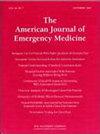Nebulized ketamine for acute pain management in the Emergency Department: A systematic review and meta-analysis
IF 2.7
3区 医学
Q1 EMERGENCY MEDICINE
引用次数: 0
Abstract
Introduction
Ketamine administered in sub-dissociative doses has been effective in managing a variety of painful conditions in the emergency department (ED) and pre-hospital settings. The inhalation route of ketamine administration has gained traction over the past 5 years.
Methods
We conducted a systematic review and meta-analysis to evaluate the analgesic efficacy and incidence of adverse effects of nebulized ketamine. We searched Ovid CENTRAL, EMBASE, and MEDLINE databases for randomized controlled trials (RCTs) and observational studies from inception to January 2025, assessing pain reduction, rescue analgesia, and occurrences of adverse effects.
We used the Cochrane Collaboration tool and a modified Newcastle-Ottawa Scale to evaluate the risk of bias and the GRADE approach (Grading of Recommendations Assessment, Development and Evaluation) to evaluate the confidence in the evidence. Mean differences with 95 % confidence intervals (CI) using random effects were used for the meta-analyses.
Results
Thirteen studies met the inclusion criteria. Nebulized ketamine had equivalent efficacy to active controls in 8 RCT's. Four RCTs (n = 601) demonstrated no difference in pain reduction between nebulized ketamine and IV morphine with mean difference (MD) 0.28 (CI -0.18 to 0.73) at 30 min, and similar rates of rescue analgesia (16.9 % vs. 17.4 %). Eleven studies reported absence of serious events and no difference in non-serious adverse events (39.1 % ketamine and 37.8 % controls). The level of confidence for the outcomes was deemed to be very low.
Conclusion
Administration of ketamine via nebulization for patients with acute painful conditions provided equivalent analgesia with similar safety profile when compared to active controls.
Clinicaltrials.gov Registration: N/A.
雾化氯胺酮治疗急诊科急性疼痛:系统回顾和荟萃分析
以亚游离剂量给予氯胺酮在急诊科(ED)和院前环境中有效地管理各种疼痛状况。氯胺酮给药的吸入途径在过去5年中获得了牵引力。方法对雾化氯胺酮的镇痛效果和不良反应发生率进行系统评价和meta分析。我们检索了Ovid CENTRAL、EMBASE和MEDLINE数据库,检索了从开始到2025年1月的随机对照试验(rct)和观察性研究,评估了疼痛减轻、抢救性镇痛和不良反应的发生率。我们使用Cochrane协作工具和修改后的纽卡斯尔-渥太华量表来评估偏倚风险,并使用GRADE方法(分级推荐评估、发展和评价)来评估证据的置信度。采用随机效应的95%置信区间(CI)的平均差异进行meta分析。结果13项研究符合纳入标准。在8项随机对照试验中,雾化氯胺酮的疗效与主动对照相当。4项随机对照试验(n = 601)显示,雾化氯胺酮和静脉注射吗啡在30分钟疼痛减轻方面无差异,平均差异(MD)为0.28 (CI -0.18 ~ 0.73),且挽救性镇痛率相似(16.9% vs. 17.4%)。11项研究报告没有严重事件,非严重不良事件无差异(39.1%氯胺酮和37.8%对照组)。对结果的信心水平被认为非常低。结论氯胺酮雾化治疗急性疼痛患者的镇痛效果与主动对照组相当,且安全性相似。
本文章由计算机程序翻译,如有差异,请以英文原文为准。
求助全文
约1分钟内获得全文
求助全文
来源期刊
CiteScore
6.00
自引率
5.60%
发文量
730
审稿时长
42 days
期刊介绍:
A distinctive blend of practicality and scholarliness makes the American Journal of Emergency Medicine a key source for information on emergency medical care. Covering all activities concerned with emergency medicine, it is the journal to turn to for information to help increase the ability to understand, recognize and treat emergency conditions. Issues contain clinical articles, case reports, review articles, editorials, international notes, book reviews and more.

 求助内容:
求助内容: 应助结果提醒方式:
应助结果提醒方式:


